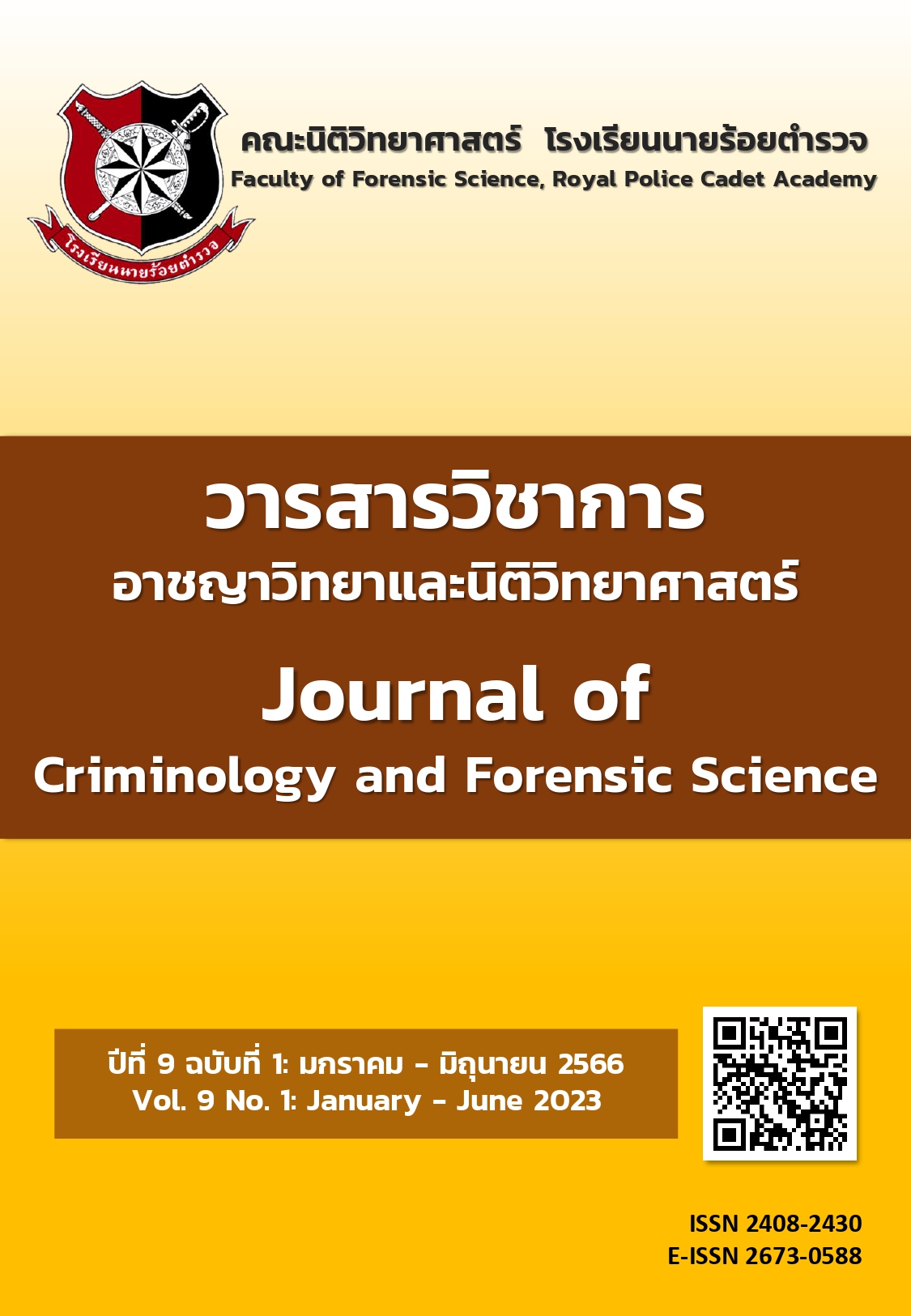ผลกระทบของมาตรการควบคุมการแพร่ระบาดของโควิด 19 ที่มีต่ออาชญากรรมในประเทศไทย
Main Article Content
บทคัดย่อ
งานวิจัยนี้มีวัตถุประสงค์ที่จะศึกษาผลกระทบของการดำเนินมาตรการเพื่อควบคุมการระบาดของโควิด 19 ที่มีต่ออาชญากรรมในประเทศไทย โดยการคาดประมาณสมการปัจจัยที่กำหนดอัตราอาชญากรรมรวม และอาชญากรรมประเภทต่างๆ โดยใช้ข้อมูลพาแนล 77 จังหวัด ตั้งแต่เดือนมกราคม พ.ศ. 2563 ถึงเดือนธันวาคม พ.ศ. 2564 รวม 1,464 ตัวอย่าง ผลการศึกษาพบว่า มาตรการควบคุมการแพร่ระบาดโดยการปิดสถานที่เสี่ยงต่อการติดต่อโรค เช่น ผับ บาร์ และสถานบันเทิงต่างๆ มีผลให้อาชญากรรมความผิดยาเสพติดลดลง ส่วนการประกาศห้ามออกนอกเคหสถาน มีผลทำให้อาชญากรรมความผิดเกี่ยวกับทรัพย์ อาชญากรรมความผิดโจรกรรมรถยนต์และรถจักรยานยนต์ และอาชญากรรมความผิดยาเสพติดลดลง อย่างไรก็ตาม การประกาศเคอร์ฟิวทำให้มีผู้กระทำผิดฝ่าฝืนประกาศเคอร์ฟิวซึ่งเป็นความผิดตาม พ.ร.ก.การบริหารราชการในสถานการณ์ฉุกเฉิน พ.ศ. 2548 จำนวนมาก จึงทำให้อัตราอาชญากรรมรวมทั้งหมดเพิ่มขึ้น นอกจากนี้ยังพบว่าปัจจัยอื่นๆ ที่มีผลต่ออัตราอาชญากรรมบางประเภท ได้แก่ การว่างงาน จำนวนแรงงานต่างด้าว และการเป็นเมืองท่องเที่ยว มีผลให้อัตราอาชญากรรมเพิ่มขึ้น ส่วนอัตราจับกุมสำเร็จของเจ้าหน้าที่ตำรวจที่สูงขึ้นจะช่วยให้อาชญากรรมลดลง
Article Details

อนุญาตภายใต้เงื่อนไข Creative Commons Attribution-NonCommercial-NoDerivatives 4.0 International License.
เนื้อหาและข้อมูลในบทความที่ลงตีพิมพ์ใน วารสารวิชาการอาชญาวิทยาและนิติวิทยาศาสตร์ โรงเรียนนายร้อยตำรวจ ถิอว่าเป็นข้อคิดเห็นและความรั้บผิดชอบของผู้เขียนบทความโดยตรงซึ่งกองบรรณาธิการวารสาร ไม่จำเป็นต้องเห็นด้วยหรือรับผิดชอบใดๆ
บทความ ข้อมูล เนื้อหา รูปภาพ ฯลฯ ที่ได้รับการตีพิมพ์ใน วารสารวิชาการอาชญาวิทยาและนิติวิทยาศาสตร์ ถือว่าเป็นลิขสิทธิ์ของวารสาร วารสารวิชาการอาชญาวิทยาและนิติวิทยาศาสตร์ หากบุคคลหรือหน่วยงานใดต้องการนำทั้งหมดหรือส่วนหนึ่งส่วนใดไปเผยแพร่ต่อหรือเพื่อกระทำการใดๆ จะต้องได้รับอนุญาตเป็นลายลักษณ์อักษรจาก วารสารวิชาการอาชญาวิทยาและนิติวิทยาศาสตร์ ก่อนเท่านั้น
เอกสารอ้างอิง
Apple Inc. (2022). Mobility Trends Reports. from https://covid19.apple.com/mobility.
Becker, G. S. (1968). Crime and Punishment: An Economic Approach. Journal of Political Economy, 76(2), 169–217.
Boman, J. H., & Gallupe, O. (2020). Has COVID-19 Changed Crime? Crime Rates in the United States during the Pandemic. American Journal of Criminal Justice, 45(4), 537-545.
De la Miyar, J. R. B., Hoehn-Velasco, L., & Silverio-Murillo, A. (2021). Druglords Don’t Stay at Home: COVID-19 Pandemic and Crime Patterns in Mexico City. Journal of Criminal Justice, 72, 101745.
Evans, D. P., Hawk, S. R., & Ripkey, C. E. (2021). Domestic Violence in Atlanta, Georgia before and during COVID-19. Violence and Gender, 8(3), 140-147.
Halford, E., Dixon, A., Farrell, G., Malleson, N., & Tilley, N. (2020). Crime and Coronavirus: Social Distancing, Lockdown, and the Mobility Elasticity of Crime. Crime Science, 9(1), 1–12.
Hoehn-Velasco, L., Silverio-Murillo, A., & de la Miyar, J. R. B. (2021). The Great Crime Recovery: Crimes Against Women during, and after, the COVID-19 Lockdown in Mexico. Economics & Human Biology, 41, 100991.
Langton, S., Dixon, A., & Farrell, G. (2021). Six Months in: Pandemic Crime Trends in England and Wales. Crime science, 10(1), 1-16.
Mohler, G., Bertozzi, A. L., Carter, J., Short, M. B., Sledge, D., Tita, G. E., ... & Brantingham, P. J. (2020). Impact of Social Distancing during COVID-19 Pandemic on Crime in Los Angeles and Indianapolis. Journal of Criminal Justice, 68, 101692.
National Statistical Office Thailand. (2022). Sector Statistics: Sector 9 Justice and Political Stability. from http://statbbi.nso.go.th/analytics. (in Thai).
Punyasavatsut, A. (2013). Determinants of Crime in Thailand: A Panel Data Analysis. Research Paper No. 11/2013 Department of Economics, Faculty of Economics, Kasetsart University. (in Thai).
Sarel, R. (2021). Crime and Punishment in Times of Pandemics. European Journal of Law and Economics, 1-32.
Stickle, B., & Felson, M. (2020). Crime Rates in a Pandemic: The Largest Criminological Experiment in History. American Journal of Criminal Justice, 45(4), 525–536.


